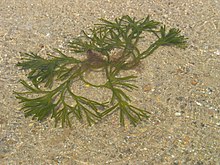
Palmaria palmata, also called dulse, dillisk or dilsk, red dulse, sea lettuce flakes, or creathnach, is a red alga (Rhodophyta) previously referred to as Rhodymenia palmata. It grows on the northern coasts of the Atlantic and Pacific Oceans. It is a well-known snack food. In Iceland, where it is known as söl, it has been an important source of dietary fiber throughout the centuries.
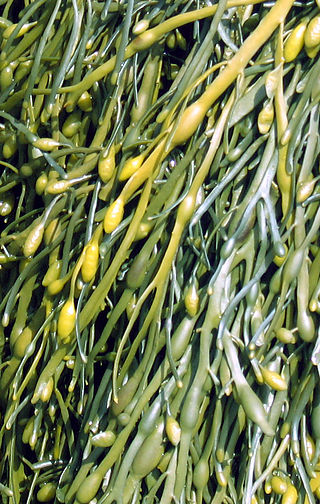
Ascophyllum nodosum is a large, common cold water seaweed or brown alga (Phaeophyceae) in the family Fucaceae. Its common names include knotted wrack, egg wrack, feamainn bhuí, rockweed, knotted kelp and Norwegian kelp. It grows only in the northern Atlantic Ocean, along the north-western coast of Europe including east Greenland and the north-eastern coast of North America. Its range further south of these latitudes is limited by warmer ocean waters. It dominates the intertidal zone. Ascophyllum nodosum has been used numerous times in scientific research and has even been found to benefit humans through consumption.
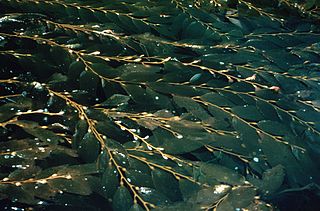
Macrocystis is a monospecific genus of kelp with all species now synonymous with Macrocystis pyrifera. It is commonly known as giant kelp or bladder kelp. This genus contains the largest of all the Phaeophyceae or brown algae. Macrocystis has pneumatocysts at the base of its blades. Sporophytes are perennial and the individual may live for up to three years; stipes/fronds within a whole individual undergo senescence, where each frond may persist for approximately 100 days. The genus is found widely in subtropical, temperate, and sub-Antarctic oceans of the Southern Hemisphere and in the northeast Pacific from Baja California to Sitka, Alaska. Macrocystis is often a major component of temperate kelp forests.
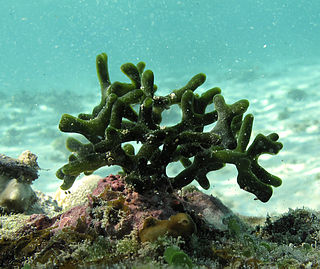
Codium is a genus of edible green macroalgae under the order Bryopsidales. The genus name is derived from a Greek word that pertains to the soft texture of its thallus. One of the foremost experts on Codium taxonomy was Paul Claude Silva at the University of California, Berkeley. P.C. Silva was able to describe 36 species for the genus and in honor of his work on Codium, the species C. silvae was named after the late professor.

Colpomenia peregrina, sometimes referred to by its vernacular names oyster thief and bladder weed, is a species of brown seaweed.
Rhipiliopsis is a genus of green algae in the family Rhipiliaceae. Johnson-sea-linkia is a synonym.

Ulva intestinalis is a green alga in the family Ulvaceae, known by the common names sea lettuce, green bait weed, gutweed, and grass kelp. Until they were reclassified by genetic work completed in the early 2000s, the tubular members of the sea lettuce genus Ulva were placed in the genus Enteromorpha.

Fucus distichus or rockweed is a species of brown alga in the family Fucaceae to be found in the intertidal zones of rocky seashores in the Northern Hemisphere, mostly in rock pools.
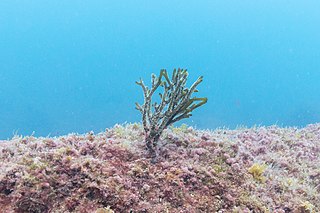
Codium tomentosum is a species of green seaweed in the family Codiaceae. Its common names include velvet horn and spongeweed.
Lobophora variegata is a species of small thalloid brown alga which grows intertidally or in shallow water in tropical and warm temperate seas. It has three basic forms, being sometimes ruffled, sometimes reclining and sometimes encrusting, and each form is typically found in a different habitat. This seaweed occurs worldwide. It is the type species of the genus Lobophora, the type locality being the Antilles in the West Indies.

Bonnemaisonia hamifera is a species of red alga in the family Bonnemaisoniaceae. Originally from the Pacific Ocean, it has been introduced into the northeastern Atlantic Ocean, where it is considered invasive on European coasts. It exists in two phases which, at one time, were thought to be different species; a medium-sized feathery form attached to other seaweeds, and a small tufted form known as Trailliella.

Codium arabicum, commonly known as green sea cushion, is a species of seaweed in the Codiaceae family.
Codium dwarkense is a species of seaweed in the Codiaceae family.
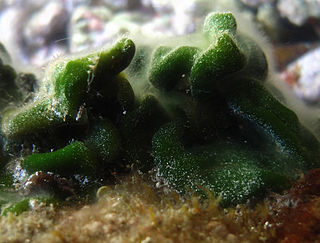
Codium spongiosum is a species of seaweed in the family Codiaceae.
Saccharina dentigera is a species of brown algae, in the family Laminariaceae. It is native to shallow water in the northeastern Pacific Ocean from the Gulf of Alaska to Baja California.

Codium bursa is a green marine algae of medium size.
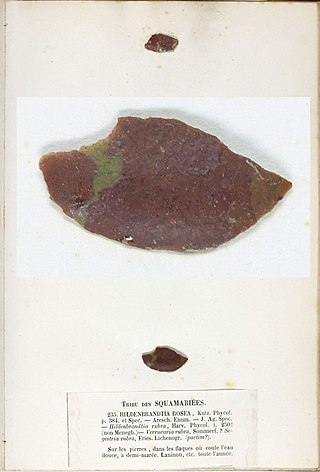
Hildenbrandia rubra is a marine species of thalloid red alga. It forms thin reddish crusts on rocks and pebbles in the intertidal zone and the shallow subtidal zone. It is a common species with a cosmopolitan distribution, and is able to tolerate a wide range of conditions.
Codium edule is a green alga common on shallow reef flats from the intertidal to the subtidal in tropical waters of the Indo-Pacific. The species is common in Hawaiʻi where it is usually called wāwaeʻiole and considered an edible alga or limu. Prominent ethnobotanist Isabella Abbott described its usage in her writing.
